Table of contents

archive
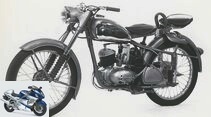
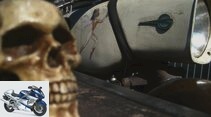
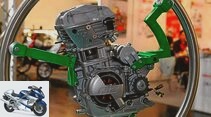
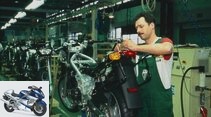
19th pictures
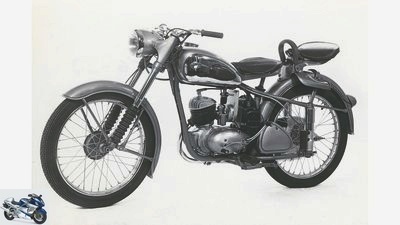
archive
1/19
The neverending MZ story: DKW RT 125.

archive
2/19
MZ died on installments. Now the inheritance is still being haggled in court.

archive
3/19
Didn’t convince the professional world: MZ 4-stroke with variable valve control.
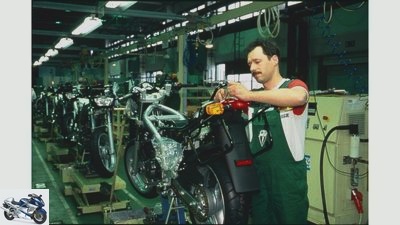
archive
4/19
The brand saved itself through the 90s with Yamaha single-cylinder engines. In the picture the assembly of a MuZ Scorpion Traveler.
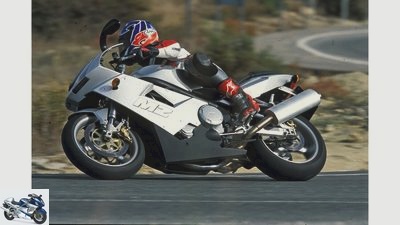
archive
5/19
MZ 1000 S.
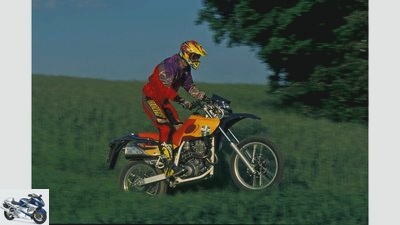
archive
6/19
MuZ Baghira.
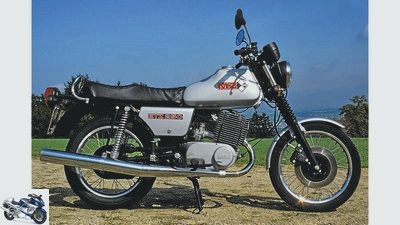
archive
7/19
MZ ETZ 250.
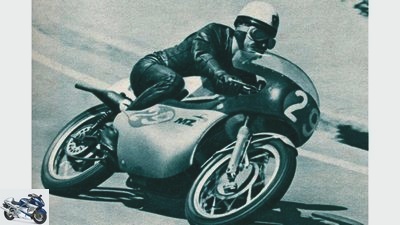
archive
8/19
Sport-MZ RE.

archive
9/19
MZ RT 125.
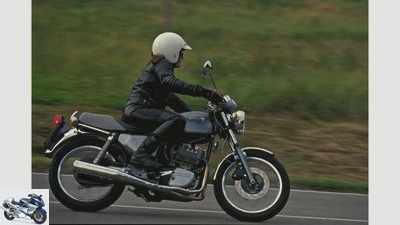
archive
10/19
MZ Silverstar Classic 500.
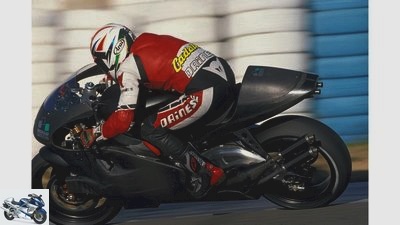
archive
11/19
MZ in racing: The Weber-Swissauto was used by MZ boss Korous in 1998/99. Luca Cadalora drove for a fee of $ 5,000 per race.
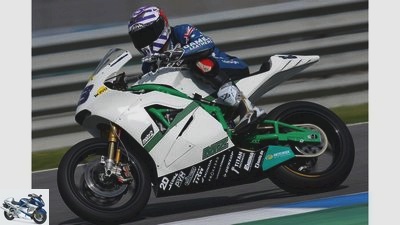
archive
12/19
MZ in racing: Anthony West on the Moto2-MZ: After two years, some trouble and meager points, he parted ways with MZ boss Wimmer.
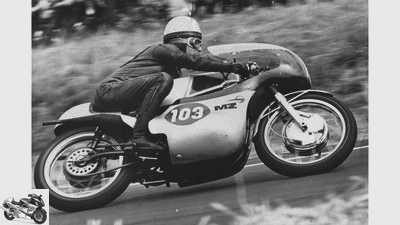
archive
13/19
MZ in racing: After a brief stint in 1960, Heinz Rosner drove the World Championship for MZ from 1964 to the end of 1968 – most recently in three classes. He was fourth in the World Cup five times, and third in the 250 cc class in 1968. In this class he was also a two-time GDR champion.
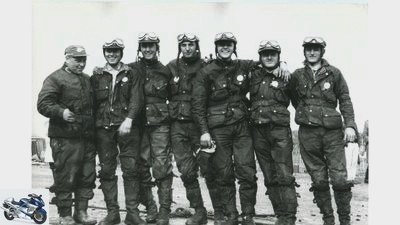
archive
14/19
MZ in racing: The Six Days on the Isle of Man became legendary because of their difficulty. The GDR trophy team (pictured) won there, as did the silver vase team.
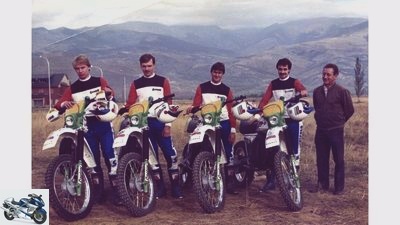
archive
15/19
MZ in racing: black-red-gold and green-white: In 1985 Andreas Cyffka, Udo Grellmann, Mike Heydenreich and Jens Gruner became European junior champions in enduro racing on MZ.

archive
16/19
Will the ignition really be on zero in 2013? Nothing is produced anymore, but there is even more arguing for it.
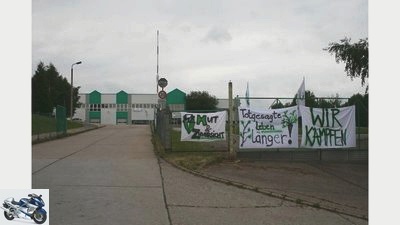
archive
17/19
No investor, no jobs, no motorcycles: the MZ workers fought for a long time with the courage of desperation.
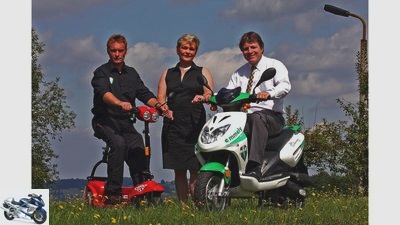
archive
18/19
Ralf Waldmann, Bettina Hager, Martin Wimmer – the trio started with big plans in 2009. Only Wimmer is still fighting, the outcome uncertain.
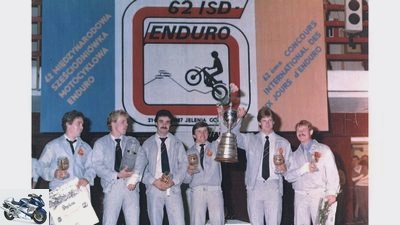
archive
19/19
MZ in racing: The winning trophy team from 1987: Reinhard Kladtke, Uwe Weber, Jens Gruner, Harald Sturm, Jens Scheffler and Jens Thalmann (from left). The Junior Trophy also went to an MZ team.
motorcycles
Spotlight: End at MZ?
Focus: That’s it for MZ?
Yesterday is over today
MZ has often been at risk in the past 20 years. And yet again and again got the curve. Now, however, it looks like there will not be another turning point in the Ore Mountains. But they still do not want to let hope sink in Zschopau.
Michael Orth, Jorn Ebberg
29/01/2009
Factual
In mid-2008, MZ’s owner, the Malaysian holding company Hong Leong, announced that it would close the plant on December 31, 2008. The last 38 employees were fired. Meanwhile, the spare parts supply continues with a few temporary employees. Like talking to investors. Is it [called. Negotiations have long been going on behind closed doors with a wide variety of interested parties. So far, nobody has wanted to spend the trendy five million on the Zschopau properties, international brand and distribution rights – the whole package.
Machine
The two-stroke engines from Saxony were simple, functional and robust. But more desirable because other desires in eastern Germany have long been in vain. Only today do you go to Emme again because you want to. at MZ it no longer rattles. And it has never really hummed in the last 20 years. What was the least about the machines. Well, at the end of the GDR era, the chrome plating left a lot to be desired, and shortly afterwards there were a few crooked cucumbers with a Rotax single cylinder. But what are the objections to the qualities that characterize motorcycles from the Ore Mountains? In the 1960s – just one example – there was virtually no passing of the enduros in off-road sport, whose success story dates back to the 1980s. That shows what potential the motorcycles – and the developers – had. How ES, ETS, TS and ETZ can still be brought back to life with a hammer and hand on the arm is one of their special charms.
The four-stroke engines, on the other hand, cannot be broken in the first place, like the VW Beetles among motorcycles: they run and run and run. And have a fan base that’s not huge, but loyal. That also speaks for the machines. Often the only problem with them was that they didn’t stop rattling in the ears of many, even though the engines had long been humming.
Human
It happened when the Treuhand announced at the end of 1991: “The Zschopau motorcycle works will be liquidated.” The then 650 employees got together and agreed to pump ten percent of their wages into their company for six months, interest-free. They were not able to prevent the bankruptcy in the meantime. But the action shows the workers’ special bond with MZ. This kind of loyalty to the Nibelung currently goes so far that some of the most recently dismissed employees did not initially take care of a new job, in the firm belief that they could return to MZ. One says that he is only “in orbit” in the new employment relationship, another thinks he is “in parking position”. “The people,” says someone who should know, one of the last employees, “live MZ.”
When the first waves of layoffs swept through the plant 20 years ago, around 300 of a good 3,500 remained. Then 250, 170, 90, 40. Ten. And yet in every conversation with former employees it is clear that their job may have been lost, but not their identification with the plant, not the sentimental, if you will, blind connection to the former size and importance of the brand. In other words: Anyone who has been with MZ for 30 years or already in the third generation has not lost a job. He’s lost a piece of himself. Once MZ, always MZ. Not always MZ, that follows from an attitude of mind that is ultimately more of an affair of the heart – unthinkable.
And when this unthinkable does occur and can no longer be ignored, it is met with the unrealistic, with fantasies. Because what cannot be cannot be. Suggestions make the rounds of an investment company to be founded, of joining Audi or – even this wish comes from the lips of an alumni – of nationalization.
Business
MZ has not earned any money since the fall of the Wall. MZ cost money. The money from the trust, the money from the Free State of Saxony, the money from several investor groups and the money from Hong Leong Industries Berhad, the Malaysian holding company that MZ bought in 1996. The fact that the company kept slipping into the red is due to “wrong investment strategies”, as the managing director Steve Yap, who was appointed in 2006, tersely and frankly admitted. That certainly does not mean that too little has been invested. It is said, however, that these investments could not lead to MZ in Germany being a profitable producer of large motorcycles. Because they went into wrong projects and because wrong things can hardly be marketed properly. Also, as I said, the machines weren’t bad.
But they didn’t reach buyers. In Germany, no more 700 people were carried away to a new MZ last year. The sales could not make up for what had been put into the development of the 660 models, the 1000 and the 125 models. The large two-cylinder machine alone is said to have devoured a budget of almost 20 million euros before the first copy was even produced for sale. No exorbitantly high development costs. But the sales figures also fell short of expectations internationally. In the opinion of the group, profits should be made primarily with small motorcycles, many of which can be sold in emerging markets.
The class that was made in Europe should mainly promote the masses in Asia with the good name. “Today the Saxon police drive Bavarian motorbikes,” says an indignant dealer from the Erzgebirge, “you have to imagine that.” Hong Leong liquidated the Malaysian MZ company in the spring of 2008. The binding period for investment grants that had gone from the state to MZ Germany ended on December 31, 2008.
Symbolic
The huge halls that stand high above the Zschopautal in Hohndorf would be almost empty if they weren’t so full of sadness. Motorcycles have not been built there since the middle of last year, and the Museales plant has not only been around since the end of production. It is big, but it has nothing left of size, for a long time this place has looked as if it had been preserved under a bell from yesterday. And with it its importance for the entire region. Which the market has never reflected after the turnaround. As a company, MZ may now be small, but as a phenomenon, MZ is still huge, even oversized. “You can close a piece of work, but not what the people of MZ have in their hearts,” it says in Zschopau. As early as 17 years ago, Der Spiegel (issue 5/1992) described the business end as “long overdue”. But the end did not come, and with every year that the manufacturer fought on, its symbolic power grew. MZ recently, that’s the underdog principle, it’s like Rocky Balboa: You watch him get spanked, how he gets up again and again, and you just wish him to stop at the end.
Big, successful, profitable, world-famous and with an insane market penetration – this has nothing to do with the current situation of the company. And yet so much. Because the present is so overwhelming that it cannot suppress this past. You always started afresh, but in a new beginning you could never break away from the burdensome old. The mortgage of the past always weighed more oppressive than financial burdens, weighed an image full of GDR and cheap two-stroke. And even if that may not be a justified image, it has remained a permanently damaging prejudice.
People don’t like to hear the truth because hearing the truth hurts. Nobody likes to see MZ as a ruinous small business, nobody likes to see MZ as a company in which an estimated 100 million euros have been sunk over the past 20 years, nobody likes to see MZ as a manufacturer without a competitive range of models. No one. Perhaps that is precisely why MZ is no longer to be understood non-symbolically. “When this flame goes out”, the Saxon Minister of Economic Affairs Thomas Jurk (CDU) announced in June 2008 after a factory visit, “a piece of Saxony’s identity dies.” For almost ten years, the Scorpions have been whistling their “Wind of Change” on hold at the MZ -Telephone system.
Possible
You couldn’t have chosen a worse time than this to – once again – stand with your back to the wall. And – once again – to hope for a turning point. The turn. Deutsche Bank put four billion euros in the sand in 2008. With an “economic stimulus package” for 50 billion, the state wants to mitigate the worst consequences of the financial crisis and stimulate demand that is already based on pumps. Nevertheless, the economic expert Ferdinand Dudenhofer predicts the domestic vehicle industry, actually Germany’s model industry, that 2009 will be “very cruel”.
MZ wasn’t an issue for a long time when it was presented. Now that the republic is concentrating on pulling global players under the state rescue umbrella, the small business in Saxony is falling through a grid in which it has nonetheless often got stuck.
Nevertheless, it cannot be ruled out that, after a long decline, the final end can still be averted. Perhaps. Possibly. At least that’s how they want to see it in Zschopau. As before, they are in talks with investors, but who it should be does not get through. Dark cars drove up to him lately, and men in dark suits got out of them to get information. About MZ. “Do you want to buy an MZ, or do you want to buy an MZ?” At some point he only asked the tie men, says a dealer of the brand. The purchase price is still five million euros, but so far nobody has paid. Either because the ominous buyers want to hold off Hong Leong to push the price down. Or because they are currently not getting the money from the banks that is necessary beyond the purchase price to turn MZ into a viable company – around 35 million euros are calculated. Or – which would be bad – because they don’t even have the requested purchase amount. It is just as possible, however, that Hong Leong can speak of negotiations in order to lure an actual interested party out of the reserve. Anyway, Steve Yap announced that he would rather sell the shop today than tomorrow. And if this project were completely hopeless, why does the shareholder leave him in Zschopau??
History of the brand
In 1906 Jorgen Skafte Rasmussen, a Dane, bought an empty cloth factory in the Zschopau valley. In the early years, the engineer had his first car accessories and household appliances produced there.
1917 Rasmussen relies on steam engines. In vain, but the abbreviation DKW later became a brand name.
In 1922, Rasmussen got onto motorcycles via detours – for example the production of toy engines. The first motorcycle to leave the factory is a 2.5 hp 148 cubic two-stroke engine.
In 1926, the actual motorcycle production on the assembly line begins in Zschopau, a real novelty at the time. The first two-cylinder is built.
In 1928 DKW takes over Audi-Werke AG Zwickau.
1929 The group grows with 60,000 machines per year and almost 2,500 employees to become the largest motorcycle manufacturer in the world.
In 1930 the global economic crisis also brought losses and layoffs in the Central Ore Mountains: only 850 employees.
In 1932, the merger of the Audi, Horch, Wanderer and DKW brands resulted in Auto Union. Trademark: four interlocking rings.
In 1936 DKW had a worldwide network of 5,000 dealers.
In 1945 the Soviets dismantled all production facilities in all plants.
In 1948 the IFA, the vehicle construction industry association, was founded and the 445 DKW employees also belonged to it when they built the first post-war model with the RT 125 the following year.
1952 The company is now called “VEB Motorradwerk Zschopau”, but the first machines under the MZ label don’t come off the production line until four years later.
In 1968 the Neckermann mail order company began to import MZ to West Germany.
1971 In the past decade, MZ has exported almost 260,000 motorcycles to 65 countries, in the Six Days competitions there is hardly any getting past the machines, and in street sports they establish themselves as a constant with some racing successes.
In 1974 3,000 machines were exported to the USA, the following year production reached a record of over 92,000 units.
In 1979 it is decided to close the main plant in the Zschopautal and relocate the company headquarters to Hohndorf.
1980s Hein Gericke assures the GDR Foreign Trade Ministry that he will import at least 4,000 machines per year into the West.
In 1983 the two millionth motorcycle rolled off the assembly line.
In 1989, 3,200 employees fear for their jobs when the market in the east collapses.
In 1990 MZ sold 70,000 machines, in 1991 only 15,000. 1950 employees.
In 1991 the company, which had only been privatized a year earlier, went bankrupt for the first time.
In 1992, MuZ GmbH was founded because the MZ naming rights had been sold. Managing Directors Wolfram Sauerbrey, Petr-Karel Korous. Presentation of some models with Rotax single cylinder.
In 1994 the manufacturer moved into the new plant, the Yamaha 660 single-cylinder Scorpion came onto the market, the Kobra study with TDM engine, the ancestor of the 1000 model, was presented.
In 1995 the Treuhand sold the production facilities for the manufacture of the two-stroke engines to Turkey.
In 1996 the Malaysian conglomerate Hong Leong Industries Berhad, a financial investor, acquired 100 percent of MZ.
In 1998, MZ tried its hand at the 500 World Cup and achieved some notable successes. The machine, however, does not originally come from MZ, but from Swiss-Auto.
In 1999 MZ is again called MZ and no longer, as since 1992, MuZ.
In 2000 MZ shows the RT 125, the first self-developed post-turnaround machine.
2001 Expansion of the 125 series to include the Supermoto SM and the Enduro SX.
In 2003 the first 1000 series were sold, the prototype of which had been shown years before.
In 2004 Korous disappears from MZ. Presentation of the 1000 SF.
In January 2005, Dr. Christoph Baumgartner as managing director of MZ, his time in the management ends at the end of the same year. 80 out of 170 employees are laid off.
In 2006 the MZ-Engineering development department is closed, Hong Leong cannot come to an agreement with several co-investors, MZ remains without participation.
2007 11.6 percent plus means 221 motorcycles sold instead of 198 as in 2006. In the case of light motorcycles, business is reduced by almost a third, 1182 125ccs are no longer sold, there are only 883 left. According to the Handelsblatt, sales are 4, 8 million euros.
2008 In June a circular reaches the dealers: The plant will be closed at the end of the year. 70 million euros in losses are given as the reason. In mid-November, the last 1000 series produced on request will be produced. On December 31 of the year, a binding period for the state of Saxony for investment grants expires. Since then, only a few employees have been taking care of the spare parts business on the basis of fixed-term contracts.
Related articles
-
Artist motorcycles Blickpunkt tour with a child Blickpunkt tour with a child Dad, when are we there? The adventure of four-year-old Paul, who crossed…
-
Presentation of the Zongshen ZS 750
motorcycles Presentation of the Zongshen ZS 750 Presentation of the Zongshen ZS 750 The fight with the dragon The Zongshen ZS 750 is the first big bike…
-
archive 19th pictures archive 1/19 The neverending MZ story: DKW RT 125. archive 2/19 MZ died on installments. Now the inheritance is still being haggled…
-
to travel Aachen-Zschopau Aachen-Zschopau Seven days for two euros A few tools, a 125cc and a plan: travel across Germany for just two euros. Eat, drink,…
-
In the spotlight: Germany’s bestseller
motorcycles In the spotlight: Germany’s bestseller In the spotlight: Germany’s bestseller And the winner is… Yes who? It all depends on which…
-
With four mopeds on the Grobglockner
Dentges 39 pictures Dentges, Lohse 1/39 Sounds crazy, but somehow it is too – four men, four mopeds and the Alps. Dentges, Lohse 2/39 Kick off and off…
-
Gargolov Sports & scene Life: Annual Review 2013 Annual review That was 2013 BMW celebrated its 90th anniversary, MOTORRAD turned 110! But there was also…
-
Photos: Obert to travel South and Central Asia South and Central Asia Around the roof of the world It’s hard to believe, but the idea came spontaneously…
-
Tourist Trophy Isle of Man 2013
Henniges 34 pictures Henniges 1/34 Everyone on the roadside is excited. Henniges 2/34 The big moment after a journey of several hours: the ferry reaches…
-
On the move: through California by motorcycle
Henniges 18th pictures Henniges 1/18 An adventure-hungry editor and companion in search of the American dream. Henniges 2/18 Intersections in the USA:…